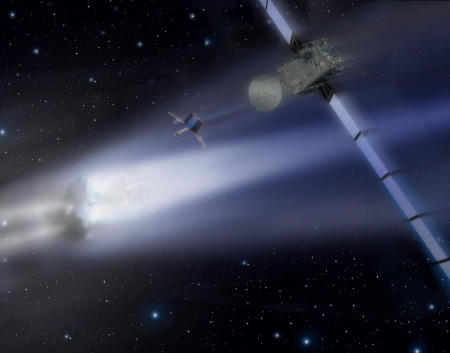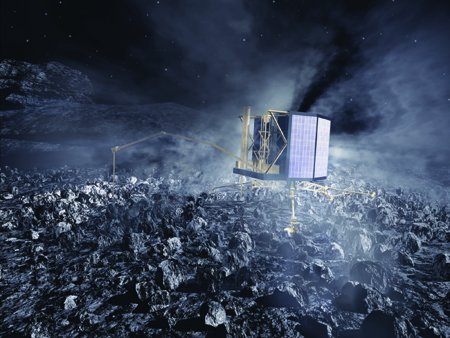 Rosetta spacecraft sends the lander Philae toward the surface of Comet Churyumov-Gerasimenko click to enlarge esa artist concept |
Rosetta will rendezvous with, measure, and send a lander down on the comet.
The spacecraft took off atop an Ariane-5G rocket on March 2, 2004. If the ten-year flight goes well, Rosetta will drop its lander onto the surface of Comet Churymov-Gerasimenko in November 2014
Probes have chased comets before, but this will be the first time a probe will have chased and then orbited a comet. It also will be the first time Earth will see close-up images of a comet with such high resolution. And, it is the first time a deep-space mission has relied on solar panels for power, rather than nuclear-generated power.
Along the way during the multi-year journey to the comet, Rosetta will pass close to one or more asteroids. The long mission duration will require extended hibernation periods for the spacecraft.
Rosetta is composed of two spacecraft. The orbiter is the mother-ship that carries the lander piggyback to the comet. They were flown to Earth orbit on an Ariane 5 rocket. In Earth orbit, Rosetta separated from the upper stage of the Ariane rocket and flew away from Earth headed for the outer region of the Solar System.
The comet orbiter. The Rosetta spacecaft looks something like a telecommunications satellite of the kind used in Earth orbit.
 Rosetta in deep space click to enlarge esa artist concept |
- The spacecraft is a boxy structure measuring about 9 feet by 7 feet by 7 feet.
- The pair of 47-ft. electricity-generating solar panels make the probe about 103 feet wide.
- It weighed 6,600 lbs. at launch with fuel more than half of that weight.
- The base of the spacecraft holds spacecraft subsystems.
- The upper houses science instruments for use at the comet.
- Rosetta carries eleven science tools that will send back to Earth data about the composition of the comet and the effects of the Sun on the comet's surface:
- remote sensing – OSIRIS, ALICE, VIRTIS, MIRO
- composition analysis – ROSINA, COSIMA, MIDAS
- examination of the nucleus' large-scale structure – CONSERT
- research into the dust flux and mass distribution – GIADA
- comet plasma environment and solar wind interaction – RPC
- radio science instrument – RSI
- remote sensing – OSIRIS, ALICE, VIRTIS, MIRO
- The Philae lander carries nine more science tools plus a drill to take subsurface samples:
- alpha-p x-ray spectrometer – APXS
- panoramic and microscopic imaging system – CIVA
- radio sounding and nucleus tomography – CONSERT
- evolved gas analyzer for elemental and molecular composition – COSAC
- evolved gas analyzer for isotopic composition – MODULUS Ptolemy
- measurements of surface and subsurface properties – MUPUS
- imaging – ROLIS
- magnetometer and plasma monitor – ROMAP
- drilling and sample retrieval – SD2
- surface electrical, acoustic and dust impact monitoring – SESAME
- alpha-p x-ray spectrometer – APXS
The Rosetta orbiter relays signals from the lander to Earth.
The comet lander. The spacecraft is carrying the German-built Rosetta lander – the so-called Surface Science Package – to the nucleus of the comet where the orbiter will drop the lander on the surface.
The Rosetta lander is named Philae, after an island in the Nile River.
 Philae lander on the surface of Comet Churyumov-Gerasimenko click to enlarge esa artist concept |
The 198-lb. lander will touch down on the comet softly on three shock-absorbing legs. Then, Philae will fire a harpoon into the tiny body to anchor the lander to the ground. The comet is so small it has almost no gravity.
The rocket. The ambitious Rosetta flight plan was made possible by the powerful boost of ESA's Ariane 5 rocket firing the probe on its interplanetary trajectory.
The European Space Agency fires space rockets from its Kourou space launch complex known as Centre Spatial Guyanais (CSG), in French Guiana on the northeastern coast of South America.
Rosetta was to have been launched in January 2003 on an Ariane 5 rocket from Kourou. Unfortunately, previous Ariane 5 launches had failed and Rosetta was postponed to February 2004, and the new comet target had to selected.
Rosetta was a special launch for ESA because it is the first spacecraft placed by Ariane 5 on an Earth-escape trajectory.
| Rosetta Itinerary | |
| Launch | 2004 February |
| First Earth gravity assist | 2005 March |
| Mars gravity assist | 2007 March |
| Second Earth gravity assist | 2007 November |
| Third Earth gravity assist | 2009 November |
| Enter hibernation | 2011 July |
| Exit hibernation | 2014 January |
| Rendezvous maneuver | 2014 May |
| Global mapping | 2014 August |
| Lander delivery | 2014 November |
| Perihelion passage | 2015 August |
| End of mission | 2015 December |
It will use the gravity of Earth and Mars to provide extra energy needed for the probe's long voyage. During those fly-bys, Rosetta will pick up speed as it heads on into deep space.
Visiting asteroids. During its multiple year voyage, Rosetta also will perform close flybys of one or two asteroids.
The duration of the lengthy mission will require the onboard instruments to be placed into hibernation for long periods.
Rosetta will arrive at Churymov-Gerasimenko and go into orbit around the comet in May 2014. For six months, Rosetta will study the comet's nucleus and environment. They will be traveling together through the Solar System at 83,600 mph.
Then, in November 2014, the orbiter will send down the lander Philae to the surface of the comet.
Those dirty snowballs and icy mudballs we call comets are water ice and frozen gases mixed with dust samples from the earliest history of our Solar System. Comets have been seen and reported since antiquity.
As a comet flies near the Sun, it starts to melt. The solar wind drives ice away from the comet creating a tail.
more about comets
ESA scientists suggest that comets may contain matter left over from the birth of the Sun, planets and the Solar System because most comets seem to have formed at the same as the Solar System – an estimated 4.6 billion year ago. During those eons, comets have preserved their interior materials as if they were in a deep freeze. As other comets pelted Earth over the billion years since the Solar System formed, could they have brought to Earth such building blocks for life as water and organic materials?
Rosetta was to have been launched in 2003 on a flight to the comet 46 P/Wirtanen, arriving there about 2012. Unfortunately, that comet target had to be abandoned when the Rosetta launch was postponed after failures of Europe's Ariane 5 rockets.
Selecting the new target. ESA scientists had 12-30 months to find a suitable comet to replace Wirtanen. Faced with the necessity of changing targets, ESA scientists used the Hubble Space Telescope in orbit above Earth and the European Southern Observatory on the ground in Chile to find areplacement comet. They selected Churyunov-Gerasimenko for Rosetta.
Along the way during the probe's multi-year journey to the comet, Rosetta will pass close to one or more asteroids. The long mission duration will require extended hibernation periods for the spacecraft.
Now, if the ten-year flight goes well, Rosetta will drop a lander onto the surface of Comet Churymov-Gerasimenko in November 2014
That will be the first time for a probe to orbit a comet. It also will be the first time Earth will see such high-resolution close-up images of a comet.
The replacement target had to be chosen carefully as the box-shaped lander had to be customized for the chosen comet.
The abandoned flight path. Traveling from Earth to Comet Wirtanen, Rosetta would have made a flyby of Mars in August 2005 for a gravity assist, followed by two Earth gravity assists in November 2005 and November 2007. Along the way, the probe would have passed near two asteroids – Otawara and Siwa.
Rosetta would have arrived in the vicinity of Comet Wirtanen in 2011 for its first observations in April 2012. The spacecraft would have gone into an orbit near the comet. For 17 months, it would have flown around the comet at distances of 6-31 miles.
As the spacecraft circled the comet's nucleus, it would have dropped a lander for a soft touchdown on Wirtanen's surface. The lander would have provided a close-up look at the comet's physical condition and chemical composition.
Rosetta's science mission would have ended in 2013 as Comet Wirtanen made its closest approach to the Sun.
The flight to Comet Churymov-Gerasimenko will be very similar, but with later dates.
Rosetta will be the first European spacecraft to make close-up observations of a comet since Giotto. That deep-space probe, sent on its way by an Ariane 1 rocket back in 1985, encountered Halley's Comet and Comet Grigg-Skjellerup in deep space.
The European Space Agency was established in 1973 and is based in Paris. ESA includes 15 countries – Austria, Belgium, Denmark, Finland, France, Germany, Ireland, Italy, the Netherlands, Norway, Portugal, Spain, Sweden, Switzerland and the United Kingdom. In addition Canada and Hungary participate in some projects under cooperation agreements.
Work on the Rosetta spacecraft started in 1993. The European Space Operations Centre in Darmstadt, Germany, will control Rosetta. Transmissions to the spacecraft will be sent via ESA's 115-ft. ground station antenna at New Narcia, near Perth, Australia, and the 50-ft. antenna at ESA's ground station at Kourou.
more about ESA
Also in 2004, the European Space Agency's orbiter Mars Express has sent back evidence of water in ice at the Red Planet's south pole.
Learn more:
- Rosetta European Space Agency
- Comets Space Today Online
- Europe in Space Space Today Online
- European Deep Space Probes Space Today Online
- European Space Agency European Space Agency